The 2018 National Hockey League Trade Deadline is fast approaching, and speculation is rampant regarding who the buyers are – and what they want – and who will be selling – and what they have on offer.
The Florida Panthers are approaching the deadline without much they can really offer other teams, at first glance, anyway. Expect general manager Dale Tallon to have a quiet day. In the words of head coach Bob Boughner, “…it would have to be the perfect kind of deal.”
And who could blame the Panthers for standing pat? They’ve been playing extremely well of late, seeming to finally have adjusted to their first-year bench boss’ new system. With help on the way in the form of blue-chip prospects projected to make the roster next season, the sun seems to finally be rising in South Florida.
But maybe, just maybe, there’ll be that irresistible deal that sets the hockey world ablaze. And maybe, just maybe, the Florida Panthers will be involved.
So, with that said, here are three under-the-radar Panthers who could be dealt at the deadline.
James Reimer
Who Needs Him?
Teams in need of goaltending help.
Throughout his career, Reimer has provided league-average (or better) goaltending on some pretty horrendous teams. In 2015-16, the one time he played on a legitimate contender, Reimer went 6-2 following his trade to the San Jose Sharks, posting a .938 save percentage and three shutouts. Whether a team needs him to give their starter some rest, as injury insurance or as a fallback plan to an untrusted number one, they could certainly do worse than the affable 29-year-old.
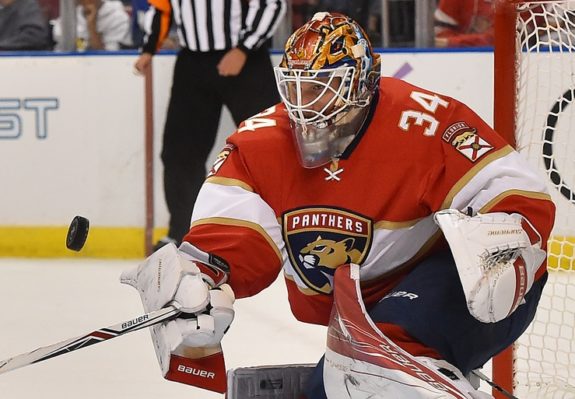
Take the New York Islanders, for example. Both Jaroslav Halak and Thomas Greiss have left much to be desired this season. Greiss is also currently on injured reserve, having hurt himself in a game last week. A playoff appearance would do wonders for the plan the Isles are trying to sell pending unrestricted free agent John Tavares, and Reimer would stabilise a shaky netminding platoon on an otherwise pretty impressive team.
Plus, the Islanders will be in need of a batterymate for Greiss next season, as Halak’s contract is set to expire. Reimer has three years left on his deal after this season at $3.4 million per year, which would bring New York’s goaltending expenditures to a very reasonable $6.7 million next season. They could certainly do worse.
Why It Makes Sense
Roberto Luongo is back with a vengeance. The veteran netminder is nearly 39 but shows no signs of deterioration in his play. Sure, he’ll need a quality backup to take a good number of games, and yes, there certainly seems to be a recurring pattern of injuries.
However, Harri Sateri showed pretty darn well starting six straight games, and highly touted prospect Sam Montembeault is already playing in the American Hockey League. Neither should cost very much to re-sign when their contracts expire (at the end of this season and next, respectively). Thus, it appears the Panthers may be able to replace Reimer from within, and could therefore use him to net both a healthy return and some more flexibility with regards to the salary cap.
Why It Doesn’t
As mentioned, Reimer has three years left on his deal. Not many teams are going to want to take on that term and over $10 million in salary cap impact, however consistent his track record might be. That’s why the Panthers would need to find a team truly desperate in net to make it work.
Also, from an internal standpoint, Luongo’s raw salary is halved each of the next two seasons. Even though his play hasn’t yet dropped off significantly, age and or injuries may eventually catch up to the future Hall-of-Famer, meaning he might be tempted by early retirement given he’ll only (“only”) be making $1.618 million in 2019-20, and $1 million in each of the last two years of the deal.
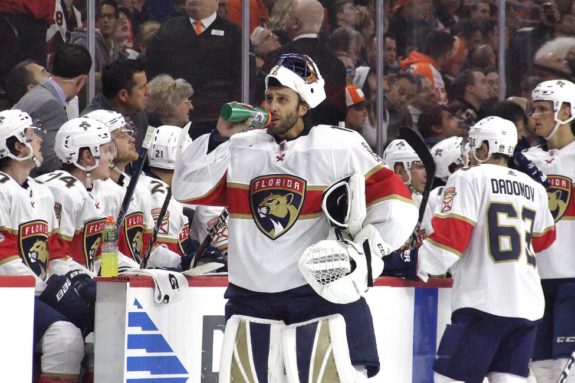
Plus, Sateri’s played only nine total NHL games in his career, and prospects (i.e. Montembeault) are always a crapshoot – goaltenders more than most.
So, Reimer might be needed after all. If a deal is made, the Panthers had better make it worth it.
Nick Bjugstad
Who Needs Him?
Teams wanting size, skill and secondary scoring up front.
Bjugstad is listed at six-foot-six and 218 pounds, and takes the ice with a devastating shot and a set of hands that belies his enormous stature. He can play either centre or the wing, and comes signed for three more seasons after this one, at $4.1 million per year.
Why It Makes Sense
Martin Hanzal is why. The equally massive Dallas Stars forward is older (31, to Bjugstad’s 25), less productive (career highs are 16 goals and 41 points, to Bjugstad’s 24 and 43) and seems to be more injury-prone. And yet, the Minnesota Wild shelled out a king’s ransom for the veteran Czech at last year’s trade deadline.
Perhaps even more puzzling, the Dallas Stars signed him to three years at $4.75 million per season this past summer.
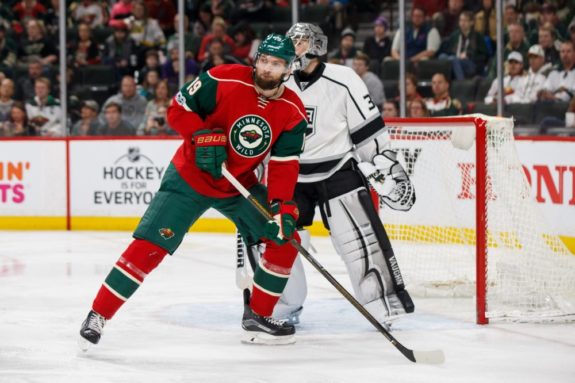
Why, you ask?
Size, skill and potential. NHL front offices salivate at the thought of polishing an rough, uncut gem into a gleaming finished product – especially when that gem also happens to be six-foot-six.
Hanzal, like Bjugstad, was a highly touted prospect and entered the league with high expectations. Like Bjugstad, Hanzal has, despite occasional flashes of brilliance, been unable to put everything together at the NHL level.
It cannot be ignored that players with this combination of size and skill don’t come along every day. And it also cannot be ignored that some organisations are willing to pay through the nose for a chance to solve these Rubik’s Cubes.
So why shouldn’t the Panthers see what they can get?
Yes, $4.1 million is a lot and yes, it’s for three more years after this one, but the salary cap is set to go up next season, so some cost certainty, combined with at least some offensive production, is never a bad thing. Plus, if you do manage to crack the code, you’ll be remembered forever as a genius.
Why It Doesn’t
Martin Hanzal is why.
No doubt the 29 other teams watched what transpired last season – the lopsided trade followed by the Wild’s first-round exit from the playoffs, not to mention Wild owner Craig Leipold publicly expressing regrets about the deal, and took to heart the fact that mortgaging the future for someone with a history of mediocrity just isn’t worth whatever the chances are of hitting a home run.
Plus, it’s not as though taking on Bjugstad would be a relatively harmless rental transaction; he’d be sticking with that team for three more seasons. So, if he doesn’t perform at the very least up to expectations, if not the price the team pays, said organisation will be reminded of their misstep for a long, long time to come.
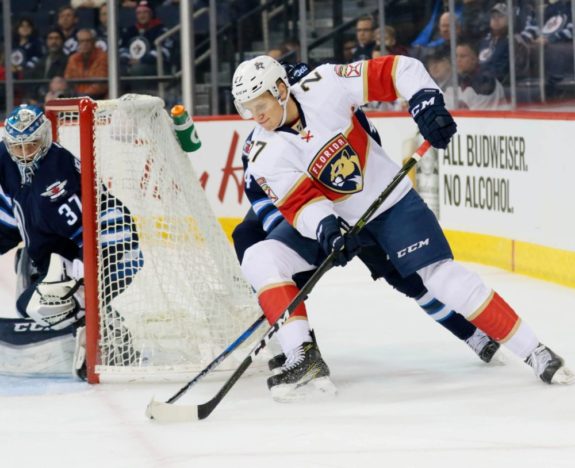
Furthermore, for whatever reason, Florida seems to place a very high value on Bjugstad, even protecting him in last year’s expansion draft at the expense of some other, much-better players. So it doesn’t seem likely they’d put him on the block in the first place.
Jared McCann
Who Needs Him?
Cap-strapped (or budget-conscious) teams in need of speed and secondary scoring.
McCann’s offensive numbers don’t immediately jump off the page, but keep in mind he’s buried on the third line of a Panthers team that really only has one line that can score. Make no mistake: McCann is for real. He’s got a great offensive skillset and can absolutely fly. A team could even put him on the wing, should their centre situation be too crowded.
Best of all, McCann is cheap, making only $894,167 this season. Even if he hits all his performance bonuses, that number will only go up to $1,106,667. Of course, the team taking him on would only have to pay a fraction of that, given that the season is almost over. Even better, his contract is up at the end of the year, at which point he’ll be a restricted free agent, giving his team a very good shot at re-signing him, should they so desire.
Why It Makes Sense
Florida’s top two centres, Aleksander Barkov and Vincent Trocheck, are both signed through 2021-22. They’re not going anywhere. Meanwhile, all signs point to top prospect Henrik Borgstrom challenging for a centre spot on the team next year. It doesn’t look like there’ll be a whole lot of room at the inn for McCann in Florida, unless he shifts to the wing.
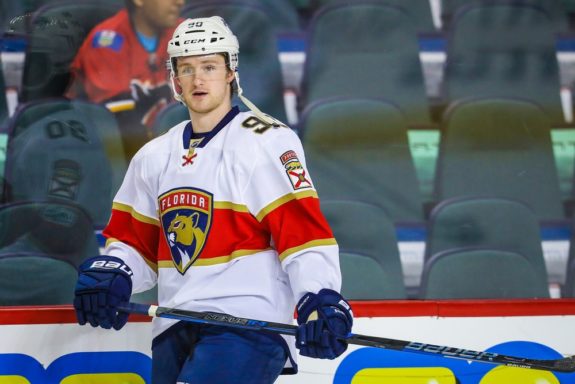
Trading away talented players is, generally, not a recipe for success, but neither is letting talent waste away at the bottom of your lineup. The Cats are about to get real crowded up front; they might as well get something for McCann now, before teams realise the Panthers are over a barrel.
Why It Doesn’t
The trade to bring McCann to South Florida was one of the more memorable fleecings in recent history. I can’t imagine the Panthers being overly enthusiastic about trading away the centrepiece of one of the only deals in recent memory where they didn’t come out the other the worse for wear.
Plus, McCann’s undoubtedly a very gifted offensive forward, so they’d be losing out on the potential returns further investment in him might provide.
On the flip side, despite all the potential, McCann hasn’t really accomplished anything of note in his admittedly short career (he’s only 21), so the Cats may have difficulty finding a dance partner in the first place.
Daring Deals Likely Deadline Dreams
All of this speculation is a whole lot of fun but, let’s be honest, we all know the trade deadline is rarely that exciting.
The Panthers have shown rather well of late, at last sniffing the playoff hunt after months of misery in what appeared to be another lost season in South Florida. Everyone’s finally healthy and they’ve got a boatload of promising prospects in their pipeline. Thus, though Tallon should always be working the phones – especially at this time of year, when teams are getting desperate – and exploring all possible options, the best thing to do might just be to stand pat.
Of course, standing pat is often the hardest thing to do, too. After all, it can’t hurt to see what’s out there…
It’s always fun to dream.
(All salary cap information is thanks to CapFriendly.)